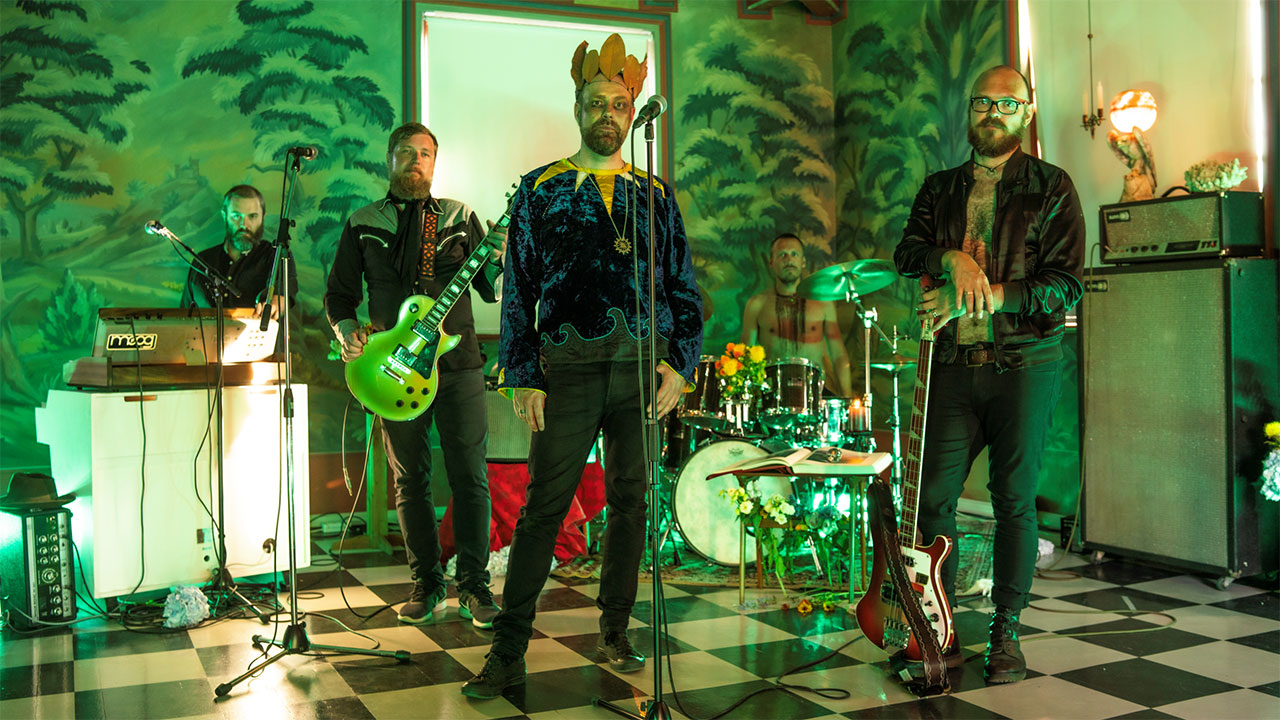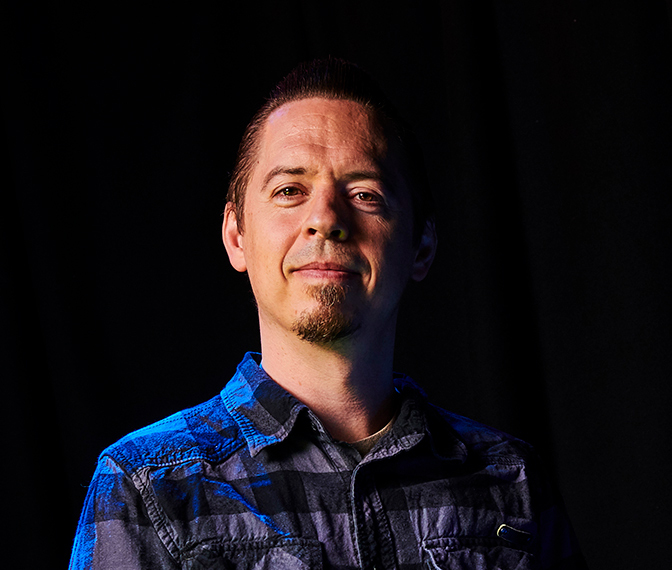“The main thing is that we want to make good songs, good music, and not really think too much about it being progressive for the sake of it,” says Andreas Prestmo, frontman of Norway’s Wobbler. His statement shouldn’t be read as any sort of repudiation of progressive rock, though. Wobbler’s sound is firmly rooted in analogue keyboards, and their new album, Dwellers Of The Deep, has a wonderful, vintage prog vibe, complete with lengthy, multifaceted compositions. But with their fifth long-player, they don’t want to just bust chops. “We really have matured as songwriters,” says Prestmo. “The last couple of years, while trying out new material and jamming, it’s been very important for us to make good songs with a coherent feel and a good flow, and not just stack difficult parts and sections on top of each other just because, oh, it’s so fun going from 9/8 to 17/4.”
Adds bass player Kristian Hultgren: “This time we composed, recorded and refined during the course of three years, while with From Silence To Somewhere it was six years.”
Although three years is hardly throwing an album together in a rush, much of the music was born out of the band jamming. The group assembled at the home of guitarist Marius Halleland over a long weekend to develop material for Dwellers… but it ended up being a longer session than they had anticipated. “We actually got stuck in a blizzard so we couldn’t get back to Oslo, so it was really intense and very inspiring,” says keyboardist Lars Fredrik Frøislie. “We just played all damn night and we squeezed something out of it.”
Thematically, the album was influenced by Prestmo reading about mythology, Carl Jung and psychology to explore the unilluminated recesses within the human mind.
“It ended up like a journey into your own core. Where do these feelings come from, all the dark sides you have inside?” says Prestmo, who draws a line of continuity that runs from the new album back through 2017’s From Silence To Somewhere and 2011’s Rites At Dawn. “Those two records, even though it’s kind of the same themes deep down, are more like an outside view,” he says. “The new record is more introspective with the same themes around changes, life and its mysteries, but on a much more personal and emotional level. I was very inspired by all kinds of mythologies and how these stories say something that has value for all human beings, not for the specific protagonists of the story.”
“The title, Dwellers Of The Deep, is focused on something inside us that can be good, can be bad, but it can also be all things between good and bad,” says Hultgren. “At some point you should deal with it. And how you deal with it, how it expresses itself through you, that’s what I was thinking about.”
“Basically, it’s about growth, it’s about evolving,” adds Frøislie, “it’s about acceptance of the bigger picture of who we are, that we are not just one-sided. It’s like monster and god in one peculiar creation.”
It’s Frøislie who handles the engineering and mixing duties for the band, so they maintain full control of the creative process, refining their approach across their output from 2005’s debut Hinterland through to the present. “I think we’ve nailed the sound this time,” he says. The group embrace the analogue and aren’t interested in an ultra-processed end result, which helps to explain how they’re able to effectively channel the vibe of classic progressive rock from the pre-Pro Tools age. “We keep the warts and all,” he adds. “You can hear pops and wobbles on the Mellotron and maybe the drums play a little off but that’s part of what makes it live. On From Silence To Somewhere we recorded the drums with three microphones to capture the whole kit, Led Zeppelin-style. This time we used two overheads and close-mic’ed the tom-toms, but still had a very natural sound. The grand piano had this ringing when I played certain chords, which is not like a sample where that doesn’t happen. It’s what makes it live.”
It’s increasingly rare in this day and age to hear an album that hasn’t been digitally tweaked and edited until every trace of humanity has been bleached out of the music. “A lot of things you hear are so polished, everything is so accurate,” agrees Prestmo. “I don’t think any of us had the notion that music needs to be like that. It’s a living, breathing thing. What you get out of it, what it does for you, feelings, that’s the point. You’re not bothered about the pops and the cracks and whatever if it speaks to you.”
It’s still a challenge for the band to make sure they don’t get tangled up in the technicalities. “At the end of when we were mixing and mastering, we were very focused on frequencies, but you have to take a step back,” says Frøislie. “Do we get to say what we mean with this music? That’s important to take a step back and just flow with it.”
None of this is to suggest that their music is thrown together or slapdash. It’s just that Wobbler’s approach is to get the right sound at the outset, not to dial it in later on a computer. “We spend quite a lot of time before we press the record to get the sound we want out of the amplifier, or to get the correct acoustic drum sound before we pick up the microphones,” says Hultgren. “Before we start recording, we spend a lot of time with the amplifier settings. The sound has to be good from the start.”
The band were driven by the desire to avoid another six-year gap between albums and started thinking about what would eventually become Dwellers Of The Deep as soon as they had finished From Silence To Somewhere. Some of their ideas date back further than that: the germ that became the opening track, By The Banks, dates back to 2011. “Basically, we knew that we had to produce something,” says Hultgren. “All of us brought something to the table. I had a couple of bass riffs that became the core of Five Rooms, and Marius had some bits so we pulled together what we had and then started the rather long journey of how to use them properly for a finished song.”
One of the challenges that’s perhaps more particular to progressive rock than any other genre is knowing when a track is finished. “We’re a good example of how not to do that,” laughs Hultgren. “Back in 2005, the title song from Hinterland was actually 12 minutes long before we started tweaking it and fiddling about and adding new parts. It ended up being 28, so we probably should have stopped. From that perspective, how do we know when it’s finished? That’s a good example, we really didn’t know when it was finished. Hinterland was finished when we were so exhausted that we couldn’t do anything more with it.”
The bassist says they’ve learned from their past indulgences. “We could always make another transition, another part to a song that’s already 30 minutes long, but I think we’ve learned that it’s better to kill your babies, or to use those babies in another song, instead of trying to always add new parts. It’s all about the flow and I think we’ve been much better at establishing a flow through the song now.”
For Prestmo, it’s all about getting under the skin of a song, a process he describes as, “working with it, opening it up, and feeling the fabric of the song. Of course, we have some discussions sometimes, but I think we have developed this mindset, an aesthetic, of how we want our songs to be. We just work with them and then everyone says, ‘Should we add a little bit more?’ ‘Okay, let’s try 40 seconds more on that riff,’ and then it’s up to a vote in the rehearsal space. ‘No? Okay, we’ll stop.’”
Once the composing and recording is finished, the final evolution takes place
when Wobbler take the tracks out live. Past highlights have included Night Of The Prog in Germany, Crescendo Festival on a beach in France, and Minnuendo Festival in Spain.
“There are no holds barred when we go out and do it live,” says Prestmo. “We don’t use a click track, we don’t try to emulate the sound of the record, so I think people get a really positive surprise. It’s like the record but it’s more vibrant, it’s more energetic, it’s even more flowy between sections. We’ve never really experienced a bad reception. It sounds a little cocky but that’s the way it is.”
The players all respond to the atmosphere in the room and they’re happy to improvise when inspiration strikes. “Suddenly the drummer flips out on something and someone picks up on it, Lars starts using new sounds,” says Prestmo. “We don’t want to be a free jazz ensemble, but we open up for spontaneous creativity.”
They’re now counting the days until they can get back onstage and showcase the new material, but while Dwellers Of The Deep delves into the murky subconscious of the human mind, it’s not music of despair. “I don’t think Wobbler will ever be the kind of band that’s going out to be dark, morose, or worship the darkest parts, negativity, everything is so dreary,” says Hultgren. “I don’t think we have it in us. We have a light and shade, peace and despair even inside the same song.”
“There is a palette of something slightly tragic,” adds Prestmo, noting that any dark corners are just part of a bigger picture. “I think it’s alive, it’s vibrant, it’s not a morose dark film that really goes nowhere and ends in misery. Even if there is misery and horror or darkness, there’s also a fragment of something hopeful, something alive.” And that’s something every prog fan needs in 2020.
This article originally appeared in Prog 115.

